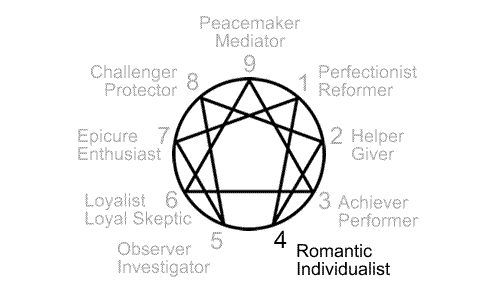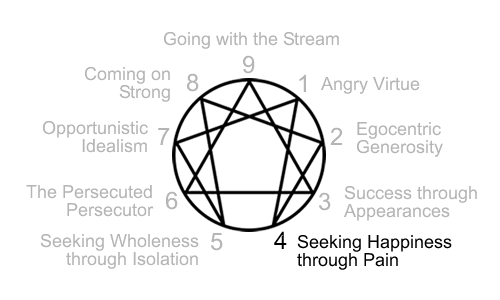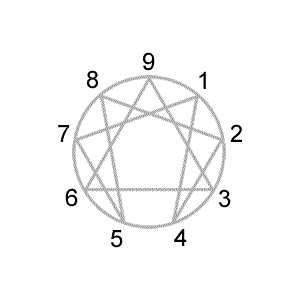Enneagram Type 4: Significance through Emotional Authenticity
The core focus of Enneagram type 4

You are unique, and if that is not fulfilled, then something has been lost.
- Martha Graham
Early in life we develop an initial belief about ourselves and a compensation for that self-belief.
-
Type 4 Initial Self-Belief: “I am lacking as I am.”
Type 4 Compensation: "I must find and cultivate what's authentic and uniquely special about myself to stand out from the ordinary."
Over time this gets generalized beyond the self into a core focus that also shapes how we perceive and interact with the world at large.
-
Type 4 Core Focus: Significance comes from cultivating what is unique and emotionally authentic in myself. This requires that I discover and stay true to what has emotional meaning for me and find ways to express that through my own identity and in the world around me.
Personality characteristics that might arise from the type 4 core focus include:
- Cultivates and maintains moods they identify with
- Holds in disdain what's common in pursuit of what's special
- Stirs up or intensifies emotional states to feel more alive
- Feels more emotionally sensitive and deeper than others
- Takes things personally even when not intended that way
- Notices what's missing or lacking in self compared to others
- Creates idealized self from what they emotionally resonate with
- Looks for ways to express their inner emotional world
- Wants to deal with internal emotions before moving forward
Enneagram author descriptions of type 4

Below are Enneagram type 4 description samplings from some popular or well-known Enneagram authors. Click on the sources after the descriptions to further explore these interpretations.
-
The Individualist, The Sensitive, Withdrawn Type: Expressive, Dramatic, Self-Absorbed, and Temperamental1
Basic Fear: Of having no identity, no personal significance1
Basic Desire: To find themselves and their significance, to create an identity out or their inner experience1
-
How Fours Pay Attention: Fours rarely live in the present. Their focus of attention travels away: to the past, to the future, to the absent, to the hard-to-get.2
Basic Proposition: You will feel loved, whole and complete if you can find the ideal love or perfect circumstance.2
Strengths: Creative, empathetic, idealistic, capable of emotional depth, compassion2
Challenges: Moody, withdrawn, self-absorbed, over-sensitive, demanding, unsatisfied with what is2
-
Energy goes into: A range of intense feelings associated with what seems to be missing or lacking in my life. Finding love, meaning, and fulfillment through self-expression and deep connection. Endeavoring to be a unique individual.3
-
The Romantic: Creative, sensitive and moody, they are motivated by a need to be understood, experience their oversized feelings and avoid being ordinary.4
-
Romantics have sensitive feelings and are warm and perceptive.5
-
Focus of Attention: Fours focus attention on their own feelings, the feelings of others, and interpersonal connection and disconnection. They feel a sense of deficiency about their own worth, so they seek idealized experiences of qualities they perceive as outside themselves.6
Sources
1Book: The Wisdom of the Enneagram; Website: The Enneagram Institute
2Book: The Enneagram; Website: The Narrative Enneagram
3Book: The Essential Enneagram; Website: Dr. David Daniels
4Book: The Road Back to You
5Book: The Enneagram Made Easy
6Book: The Complete Enneagram; Website: Chestnut Paes Enneagram Academy
Type 4 Ego: Ego-Melan

The roots of the Enneagram types come from Oscar Ichazo's ego types. The ego types identified how a person was fixated in ego and the remedy for finding freedom from that.
Below are descriptions of Oscar Ichazo's ego type 4 fixation, trap, holy idea, passion, and virtue reinterpreted for today's Enneagram personality types.
Type 4 Fixation and Trap
Fixation: Melancholy comes from a dissatisfaction with what is and a longing for what once was or could've been.
Trap: Authenticity comes from finding a sense of self and significance that expresses your unique gifts and individuality.
The fixation of melancholy points to the mental preoccupation of the type 4 ego. The trap of authenticity keeps an individual stuck in the fixation.
Type 4 Holy Idea
Holy Idea: Holy Originality involves accepting the common and ordinary in life instead of disdaining it in favor of the unique and special.
The fixation of melancholy and trap of authenticity keep an individual stuck in the type 4 fixation. The way out of that fixation is through holy originality.
Type 4 Passion
Passion: Envy is a one-sided comparison between the positives of others and the negatives of oneself. "What's lacking in me that I don't have what they have?"
The passion of envy is the emotional energy that serves the fixation of melancholy and trap of authenticity.
Type 4 Virtue
Virtue: Equanimity appears when you also see the positives you have to offer instead of just the negatives when comparing yourself to others.
The virtue of equanimity is what appears when the passion of envy subsides.
Personality traits of Enneagram type 4

A psychiatrist named Claudio Naranjo evolved Oscar Ichazo's ego-types into the Enneagram personality types as we use them today. Naranjo largely based the types on Ichazo's passions.
Naranjo outlined the following trait structure for type 4 (Ennea-type IV) in his books Ennea-type Structures and Character and Neurosis.
- Seeking Happiness through Pain - Envy and the Masochistic Personality
- Envy
- Poor Self-Image
- Focus on Suffering
- "Moving Toward"
- Nurturance
- Emotionality
- Competitive Arrogance
- Refinement
- Artistic Interests
- Strong Superego
Enneagram type 4 examples
While reading about the Enneagram types can be useful in understanding them, you eventually have to bring the types to life by seeing the many different ways they get expressed in life.
While the ideal is to be able to interact directly with people of each type, an alternative is to observe them from a distance. There are a number of ways to do this using videos. Many of these videos can be found on the Internet if you know what to look for (YouTube in particular).
- Type 4 Interviews and Self-Revelations
One method used to bring the types to life when teaching the Enneagram types involves interviewing people of a given type about how that type plays out in their life. This may be done through panels and one-on-one interviews.
Self-revelatory videos can also be useful where a person simply describes their type to a camera without the prompting of an interviewer.
Note that sometimes a person in a video may have been mistyped and may not offer an accurate representation of type when that happens.
- Type 4 Celebrities or Famous People
Once their Enneagram type is known, celebrities or famous people can also offer interesting examples of and insights into Enneagram type as revealed through interviews, lectures, writings, and the person's work.
However, it's not like the Enneagram panels, interviews, and self-revelations where people are specifically describing how they experience Enneagram type in their lives. It's more a matter of looking for glimpses into how Enneagram type is operating in the person.
It can be difficult to type someone at a distance. Look for a consensus of opinion on a person's type from multiple sources and hold it loosely. Celebrities and famous people are often typed differently by different Enneagram authors, teachers, and enthusiasts.
- Type 4 Fictional Characters
It needs to be made clear that fictional characters are not real people, even when they are based on real people. There can be a temptation to assign Enneagram type to every character in a story, but many characters don't have that kind of consistency or depth.
Not only might there be a number of different people, usually of different types, influencing the creation or portrayal of a character but often the character is nothing more than a vehicle for telling the story and moving it along.
While once in a while a character appears that you can attribute an Enneagram type to, generally it's more accurate to look at specific scenes as examples of a type rather than the character as a whole.
Tom Condon wrote a book called The Enneagram Movie & Video Guide that you may find useful for seeing type in fictional characters.
- Type 4 Songs and Lyrics
Although they do exist, there are few song lyrics that can be attributed to one particular Enneagram type. Most songs have both lyrical and musical elements that can be attributed to a number of different Enneagram types.
Songs are extremely subjective. There are many songs that listeners, and even performers, interpret in a very different way than the song writer intended. A number of songs also emphasize the sounds of words rather than their meaning.
As such, different people hearing the same song often will experience it as representing different Enneagram types.
Enneagram type 4 variations
There are a number of variations or flavors of type 4 that help explain why two people of the same type seem different. Click below for more info about variations of type 4.
Type 4 mistypes
Some people correctly identify their Enneagram type on their first try. For most other people determining type can take some time.
If you feel that you may have wrongly typed yourself as type 4 and have one or more alternative candidate types in mind then click on a link below to take a quick Enneagram test comparing type 4 to another type that may instead be your type.
Enneagram Tests to Help Determine Type

The Enneagram personality types consist of nine basic types. One of the types will be more dominant than the others. This dominant type is said to be "your Enneagram type".
Although there are nine basic Enneagram types, there are also many variations within each type as defined by such concepts as wings, centers, and instincts.
You can explore these variations using the type preference test below or one of the many other tests available on this website.
-
Enneagram Type Preference Test
This test produces a scored list of all nine types.
Questions are forced-choice, similar to the method used by the Riso-Hudson Enneagram Type Indictor (RHETI).
Use to determine type, wings, gut/heart/head types, and tri-center. -
Enneagram Type Comparison Test
This test compares any two types. The preferred type will have the higher score.
Use when you've narrowed your type down to two or three possibilities you'd like to compare.
Click here for the Complete Guide to the Enneagram.
This free guide explains- the nine Enneagram personality types
- the many type variations within type
- where the types came from (origins and history)
- how the types use the Enneagram symbol
Click here for Enneagram tests.
These free tests help you find your- primary type
- candidate types
- preferred wing
- intinctual subtype
- instinctual variant stacking
- center types (gut, heart, and head)
- tri-center with wings